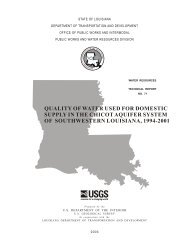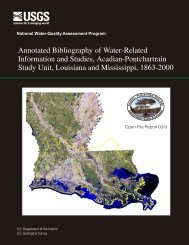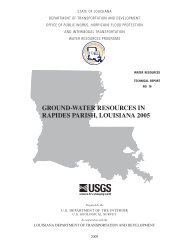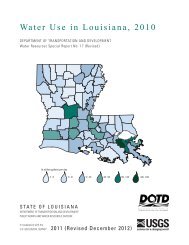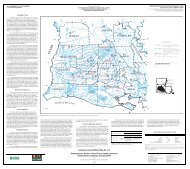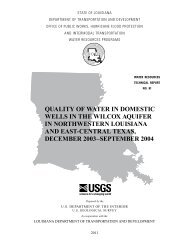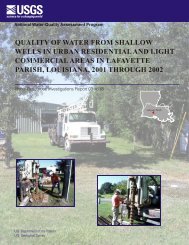environmental setting, water quality, and ecological indicators of
environmental setting, water quality, and ecological indicators of
environmental setting, water quality, and ecological indicators of
Create successful ePaper yourself
Turn your PDF publications into a flip-book with our unique Google optimized e-Paper software.
ank stability at Tortue <strong>and</strong> the reduced riparian vegetative<br />
zone at Gr<strong>and</strong> Marais also contributed to lower RBP<br />
habitat scores for these sites.<br />
Typically, organisms considered tolerant <strong>of</strong> turbidity,<br />
organic enrichment, <strong>and</strong> low dissolved-oxygen concentrations<br />
were common in the entire study area <strong>and</strong><br />
dominated the overall aquatic invertebrate community.<br />
Sensitive taxa such as Ephemeroptera (mayflies), Plecoptera<br />
(stoneflies), <strong>and</strong> Trichoptera (caddisflies) (EPT)<br />
were rare at all sites in the Mermentau River Basin <strong>and</strong><br />
were only abundant at the Whisky site in the Calcasieu<br />
River Basin. Tolerant taxa abundant throughout the Mermentau<br />
River Basin included Diptera (true flies), especially<br />
the family Chironomidae (midges); Tubificida<br />
(aquatic worms); the tolerant Ephemeroptera family<br />
Caenidae (caenids); <strong>and</strong> the Gastropoda (snails, limpets)<br />
family Physidae (pouch snails).<br />
A total <strong>of</strong> 22,678 aquatic invertebrates were collected<br />
at <strong>ecological</strong> data-collection sites, including<br />
95 species, 80 genera, <strong>and</strong> 43 families. Taxon groups <strong>of</strong><br />
Diptera were the most common (40 species), followed by<br />
Coleoptera (beetles; 14 species), Trichoptera (7 species),<br />
Ephemeroptera (6 species), <strong>and</strong> Gastropoda (5 species).<br />
Greater than 80 percent <strong>of</strong> all sampled aquatic invertebrates<br />
were accounted for by the orders Diptera (46 percent),<br />
Amphipoda (scuds, sideswimmers; 18 percent),<br />
Tubificida (7 percent), Ephemeroptera (6 percent), <strong>and</strong><br />
Gastropoda (5 percent) (app. 8).<br />
Comparison <strong>of</strong> Site Groups<br />
The study design, based on drainage area <strong>and</strong> agricultural<br />
l<strong>and</strong>-use intensity, was used to determine natural<br />
<strong>and</strong> human-related influences on surface-<strong>water</strong> <strong>quality</strong> at<br />
19 <strong>ecological</strong> data-collection sites. Aquatic invertebrate<br />
communities were used as <strong>ecological</strong> <strong>indicators</strong> <strong>of</strong> <strong>water</strong><br />
<strong>quality</strong> <strong>and</strong> habitat conditions at these sites. Through<br />
CCA, four significant (p ≤ 0.05) <strong>environmental</strong> variables<br />
(instream cover score, percentage <strong>of</strong> open canopy, <strong>and</strong><br />
concentrations <strong>of</strong> dissolved oxygen <strong>and</strong> maximum dissolved<br />
fipronil) were identified that described the distribution<br />
<strong>of</strong> aquatic invertebrate communities among<br />
<strong>ecological</strong> data-collection sites. Cluster analysis <strong>of</strong> CCA<br />
site scores from the first two axes identified four site<br />
groups which separated <strong>ecological</strong> data-collection sites<br />
geographically within the study. Environmental variables<br />
<strong>and</strong> aquatic invertebrate metrics within the studydesign<br />
(a priori, before sampling) <strong>and</strong> CCA (posteriori,<br />
after sampling) site groups were compared (fig. 7).<br />
30<br />
Study-Design Site Groups<br />
The study was designed to determine significant<br />
differences in chemical, biological, <strong>and</strong> physical habitat<br />
<strong>indicators</strong> <strong>of</strong> surface-<strong>water</strong> <strong>quality</strong> among (1) basin site<br />
groups (large <strong>and</strong> small), <strong>and</strong> (2) intensity site groups<br />
(high <strong>and</strong> low agricultural intensity). Low-intensity sites<br />
were used to characterize natural chemical, biological,<br />
<strong>and</strong> physical habitat conditions. Site groups were compared<br />
to evaluate aquatic invertebrate relations to <strong>environmental</strong><br />
variables.<br />
Stream Habitat Characteristics<br />
Significant statistical differences (p ≤ 0.05) in<br />
stream habitat characteristics occurred between basin<br />
<strong>and</strong> intensity site groups (table 8). Bank erosion scores<br />
<strong>and</strong> bankfull <strong>and</strong> wetted channel widths differed between<br />
basin site groups, whereas the bank stability index <strong>and</strong><br />
pool substrate differed between intensity site groups.<br />
Differences in bank characteristics, channel width, <strong>and</strong><br />
pool substrate may account for some differences in<br />
aquatic invertebrate communities among site groups.<br />
Generally, median bank erosion scores <strong>and</strong> median<br />
measurements <strong>of</strong> bankfull <strong>and</strong> wetted channel widths<br />
were greatest at sites with large drainage areas. Median<br />
bank erosion scores at large-basin sites were 2.5 times<br />
the scores at small-basin sites. Median bankfull <strong>and</strong> wetted<br />
channel widths at large-basin sites were at least two<br />
times the median at small-basin sites.<br />
Generally, the median bank stability index <strong>and</strong> pool<br />
substrate characterization score were lowest at all site<br />
groups with high agricultural intensity. The bank stability<br />
index (Fitzpatrick <strong>and</strong> others, 1998) was used to<br />
assess stream bank structure among site groups <strong>and</strong><br />
included bank measurements <strong>of</strong> angle, vegetative cover,<br />
height, <strong>and</strong> substrate. A higher bank stability index indicated<br />
a less stable bank. Eighty percent <strong>of</strong> the sites were<br />
classified as having unstable banks. High-intensity sites<br />
had greater bank stability (smaller median bank stability<br />
index) than low-intensity sites. Differences in the bank<br />
stability index between intensity site groups were attributed<br />
to differences in bank height. As bank height<br />
increased the bank stability index increased. The median<br />
pool substrate characterization score at low-intensity<br />
sites was more than 1.5 times the score at high-intensity<br />
sites. The high-intensity sites had mud- or clay-dominated<br />
pool substrate containing few or no root mats <strong>and</strong><br />
little or no submerged vegetation. Pool substrate at lowintensity<br />
sites was fine s<strong>and</strong> mixed with mud or clay with<br />
some root mats <strong>and</strong> submerged vegetation.



